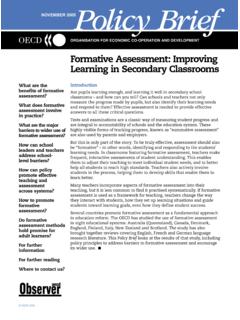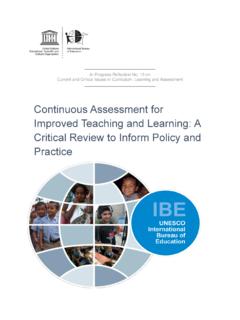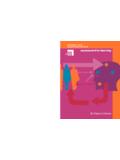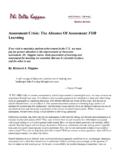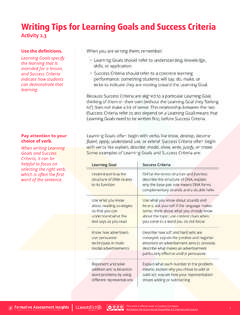Transcription of AE ASSESSMENT FOR LEARNING - OECD
1 OECD/CERI International Conference LEARNING in the 21st Century: Research, Innovation and Policy ASSESSMENT for LearningFormative AssessmentORGANISATION DE COOP RATION ETDE D VELOPPEMENT CONOMIQUESORGANISATION FOR E CONOMICCO-OPERATION AND DEVELOPMENT 1 ASSESSMENT FOR LEARNING THE CASE FOR formative ASSESSMENT This paper provides findings on ASSESSMENT for LEARNING , drawn from recent analyses undertaken by CERI. It begins with analysis of the formative approach in exemplary practice carried out in secondary schools in eight education systems.
2 The second half of the paper comprises key analyses on formative ASSESSMENT in adult language, literacy, and numeracy provision, and a framework for strengthening policy and practice across the sector as well as for building the evidence base. ASSESSMENT is vital to the education process. In schools, the most visible assessments are summative. Summative assessments are used to measure what students have learnt at the end of a unit, to promote students, to ensure they have met required standards on the way to earning certification for school completion or to enter certain occupations, or as a method for selecting students for entry into further education.
3 Ministries or departments of education may use summative assessments and evaluations as a way to hold publicly funded schools accountable for providing quality education. Increasingly, international summative assessments such as OECD s Programme for International Student ASSESSMENT (PISA) have been important for comparing national education systems to developments in other countries. But ASSESSMENT may also serve a formative function. In classrooms, formative ASSESSMENT refers to frequent, interactive assessments of student progress and understanding to identify LEARNING needs and adjust teaching appropriately.
4 Teachers using formative ASSESSMENT approaches and techniques are better prepared to meet diverse students needs through differentiation and adaptation of teaching to raise levels of student achievement and to achieve a greater equity of student outcomes. But there are major barriers to wider practice, including perceived tensions between classroom-based formative assessments, and high visibility summative tests to hold schools accountable for student achievement, and a lack of connection between systemic, school and classroom approaches to ASSESSMENT and evaluation.
5 The principles of formative ASSESSMENT may be applied at the school and policy levels, to identify areas for improvement and to promote effective and constructive cultures of evaluation throughout education systems. More consistent use of formative ASSESSMENT throughout education systems may help stakeholders address the very barriers to its wider practice in classrooms. This overview shows how formative ASSESSMENT promotes the goals of lifelong LEARNING , including higher levels of student achievement, greater equity of student outcomes, and improved LEARNING to learn skills.
6 The chapter then discusses barriers to wider practice of formative ASSESSMENT and ways in which those barriers can be addressed, and outlines the study scope and methodology. Meeting goals for lifelong LEARNING Each of the national and regional governments participating in this study promotes formative ASSESSMENT as a means to meeting the goals of lifelong LEARNING . They are motivated by quantitative and qualitative evidence that teaching which incorporates formative ASSESSMENT has helped to raise levels of student achievement, and has better enabled teachers to meet the needs of increasingly diverse student populations, helping to close gaps in equity of student outcomes.
7 Teachers using formative ASSESSMENT 2 approaches guide students toward development of their own LEARNING to learn skills skills that are increasingly necessary as knowledge is quickly outdated in the information society. Promoting high-performance: raising levels of student achievement formative ASSESSMENT methods have been important to raising overall levels of student achievement. Quantitative and qualitative research on formative ASSESSMENT has shown that it is perhaps one of the most important interventions for promoting high-performance ever studied.
8 In their influential 1998 review of the English-language literature on formative ASSESSMENT , Black and Wiliam concluded that: .. formative ASSESSMENT does improve LEARNING . The gains in achievement appear to be quite considerable, and as noted earlier, among the largest ever reported for educational interventions. As an illustration of just how big these gains are, an effect size of , if it could be achieved on a nationwide scale, would be equivalent to raising the mathematics attainment score of an average country like England, New Zealand or the United States into the top five after the Pacific Rim countries of Singapore, Korea, Japan and Hong Kong.
9 (Beaton et al., 1996, Black and Wiliam, 1998, p. 61) These findings provide a strong foundation for further research on effective teaching, LEARNING and ASSESSMENT strategies (including the present study). Promoting high-equity: education for all The What Works case studies support the idea that formative ASSESSMENT methods may help create greater equity of student outcomes. Although Black and Wiliam (1998 and in Part III of this study) note that research on the effectiveness of formative ASSESSMENT is lacking in regard to underachieving students or students race, class, or gender, it is worth noting that several of the case study schools with large percentages of disadvantaged students had moved from failing to exemplary status over the past several years.
10 Case study schools featuring programmes specifically targeted to the needs of underachieving students also yielded positive results. Teachers in the case study schools used formative ASSESSMENT to establish factors lying behind the variation in students achievements in specific subjects, and to adapt teaching to address identified needs. Such approaches represent a move away from models of equity that suggest that all children should receive exactly the same inputs (they are indifferent to difference , Perrenoud suggests [1998]), or deficit models that identify certain children as disadvantaged.










